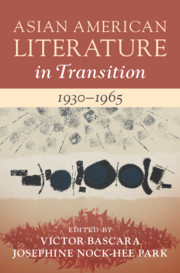Book contents
- Asian American Literature in Transition, 1930–1965
- Asian American Literature In Transition
- Asian American Literature in Transition, 1930–1965
- Copyright page
- Contents
- Figures
- Contributors
- Series Preface
- Introduction
- Part I Transitions Approached through Concepts and History
- Chapter 1 The Popular Front and Asiatic Modes of Cultural Production
- Chapter 2 Asian American Realism
- Chapter 3 On Modernism, Decolonization, and Asian American Literature in Transition
- Chapter 4 The Cultures of Japanese Internment
- Chapter 5 The 1947 Partition, War, and Internment
- Chapter 6 Cold War Fiction
- Chapter 7 Desert, Island, Ocean, Swamp
- Part II Transitions Approached through Authors, Texts, Concepts, and History
- Select Bibliography
- Index
Chapter 5 - The 1947 Partition, War, and Internment
Hidden Histories of Migration and Displacement in Transnational Asia
from Part I - Transitions Approached through Concepts and History
Published online by Cambridge University Press: 27 May 2021
- Asian American Literature in Transition, 1930–1965
- Asian American Literature In Transition
- Asian American Literature in Transition, 1930–1965
- Copyright page
- Contents
- Figures
- Contributors
- Series Preface
- Introduction
- Part I Transitions Approached through Concepts and History
- Chapter 1 The Popular Front and Asiatic Modes of Cultural Production
- Chapter 2 Asian American Realism
- Chapter 3 On Modernism, Decolonization, and Asian American Literature in Transition
- Chapter 4 The Cultures of Japanese Internment
- Chapter 5 The 1947 Partition, War, and Internment
- Chapter 6 Cold War Fiction
- Chapter 7 Desert, Island, Ocean, Swamp
- Part II Transitions Approached through Authors, Texts, Concepts, and History
- Select Bibliography
- Index
Summary
This chapter uncovers how the 1947 Partition of India shapes South Asian America in particular, and Asian America more generally. Engaging with recent Asian American studies of war and displacement, it situates Partition in its wider history of decolonization and the emergent Cold War from 1930 to 1970, to show how it constitutively shapes South Asian American literature about the circuits of travel, migration, internment, and displacement that link Asia and Asian America. In this period, South Asian writers and critics like Santha Rama Rau circulated back and forth between the USA, England, and Asia, and produced writing that reflected on race relations in the USA and under empire; the traumatic mass migrations of 1947; and the geopolitical and ideological conflicts linked to the Cold War that shaped decolonization in Asia. Daiya traces the linkages between the 1947 Partition and subsequent border conflicts and war in South Asia, including Tibetan refugees’ exile in India, the little-discussed 1962 war between India and China, and Chinese-Indians’ ensuing, traumatic internment. This chapter shows how inter-Asia solidarities and conflicts, along with US involvement, shaped South Asia in this period of radical transformation and realignment in Asia, and for Asian America.
Keywords
- Type
- Chapter
- Information
- Asian American Literature in Transition, 1930–1965 , pp. 87 - 107Publisher: Cambridge University PressPrint publication year: 2021



